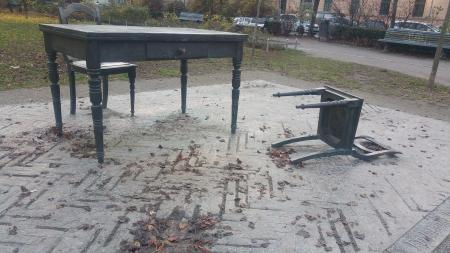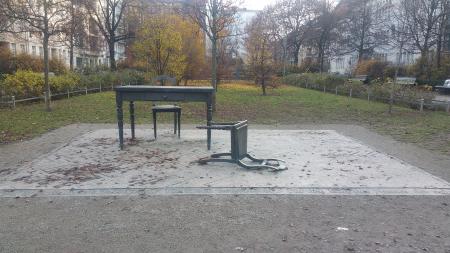Obj. ID: 49085
Modern Jewish Art Abandoned Room Holocaust Memorial in Berlin, Germany, 1988-1996

Memorial Name
The Abandoned Room (Der verlassene Raum)
Who is Commemorated?
Victims of Kristallnacht
Description:
In a small urban park in the center of what was once a Jewish neighborhood, is a realistic sculpture that depicts a table and two chairs seemingly set on a parquet floor. One chair is by the table, while the other is knocked over and lies on the floor on the other side. All the elements appear cast from actual wood pieces and present an intense sense of reality. The impression is that this room was abandoned in a hurry.
Around the edge of the “floor” are inscribed lines from a poem by Nobel Prize winner Nelly Sachs, from her poem “O die Schornsteine” (“O the Chimneys”), published in 1947, which evokes the crematoria of the Death Camps.
Inscriptions
German
…O die Wohnungen des Todes,
Einladend hergerichtet
Für den Wirt des Hauses, der sonst Gast war-
O ihr Finger
Die Eingangsschwelle legend
Wie ein Messer zwischen Leben und Tod –
O ihr Schornsteine,
O ihr Finger,
Und Israels Leib im Rauch durch die Luft! – Nelly Sachs
Translation: …Oh the houses of death / invitingly appointed / or the landlord of the house who was once a guest / Oh you fingers, / Laying the threshold / like a knife between life and death / Oh, you chimney stacks, / Oh you fingers, / And the body of Israel going up in smoke! Nelly Sachs
Commissioned By
[To be added]
sub-set tree:
In the late 1980s, the GDR began to commemorate the fate of its German Jews. In 1988, the same year restoration work started on the nearby Neue (New) Synagogue, plans were begun for a memorial to the victims of the Kristallnacht pogrom. In 1989, a competition was held, and Karl Biedermann and Eva Butzmann won it. There were delays in the project’s completion during the reunification period, and The Abandoned Room was completed in 1996.
The sculpture is intended to evoke a sense of surprise, urgency, and loss. Th view is left to imagine if the occupants of the room fled in haste, and if so, what was their fate, or if they were suddenly seized by Nazi police, and taken to a concentration camp, or even to their deaths.
Di Bella, Maria Pia. "Walking Memory: Berlin's 'Holocaust Trail'." Journeys, vol. 13, no. 2, Dec. 2012, pp. 55+. Gale Literature Resource Center,, link.gale.com/apps/doc/A317469046/LitRC?u=anon~1e686315&sid=googleScholar&xid=fd5ce0ee (accessed May 3, 2023)
Pearson, Joseph. “The Deserted Room,” The Needle, September 29, 2018, https://needleberlin.com/2018/09/23/the-deserted-room/ (accessed May 3, 2023)





















